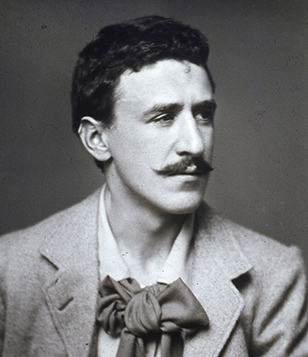Scottish Roots – We trace your Scottish Family tree
Famous Scots

Charles Rennie Mackintosh
Architect & Designer
Mackintosh was born in Glasgow, Scotland and died in London, England. He is among the most important figures of Modern Style (British Art Nouveau style).
Charles Rennie Mackintosh was born at 70 Parson Street, Townhead, Glasgow, on 7 June 1868, the fourth of eleven children and second son of William McIntosh, a superintendent and chief clerk of the City of Glasgow Police. He attended Reid’s Public School and the Allan Glen’s Institution from 1880 to 1883. William’s wife Margaret Mackintosh née ‘Rennie’ grew up in the Townhead and Dennistoun (Firpark Terrace) areas of Glasgow.
He changed the spelling of his name from ‘McIntosh’ to ‘Mackintosh’ for unknown reasons, as his father did before him, around 1893. Mackintosh is also sometimes referred to affectionately as ‘Toshie’, a nickname seen in correspondence and other contemporary literature written by friends and family members.
Mackintosh entered the architectural profession in 1884 as an apprentice to John Hutchinson in Glasgow and in the evenings studied at Glasgow School of Art (situated then in Sauchiehall Street) where he became a prize-winning student. In 1889 he joined Honeyman and Keppie (John Honeyman and John Keppie), a major architectural practice as a draughtsman and designer, where in 1901 he became a partner.
His early design work as a draughtsman and lead designer can be seen from 1893 in the interior of Craigie Hall, Dumbreck, and in the new saloon and gallery of Glasgow Art Club, 185 Bath Street for which he signed the drawings.
Around 1892, Mackintosh met fellow artist Margaret Macdonald at the Glasgow School of Art. He and fellow student Herbert MacNair, also an apprentice at Honeyman and Keppie, were introduced to Margaret and her sister Frances MacDonald by the head of the Glasgow School of Art, Francis Henry Newbery, who saw similarities in their work. Margaret and Charles married on 22 August 1900. The couple had no children. MacNair and Frances also married the previous year. The group worked collaboratively and came to be known as “The Four”, and were prominent figures in Glasgow Style art and design. Mackintosh and Margaret married, setting up their first home in Mains Street on Blythswood Hill, the street later being renamed as Blythswood Street, Glasgow. Subsequently, they moved to Southpark Avenue, close to Glasgow University.
In the early 1910s the partnership known from 1901 as Honeyman, Keppie & Mackintosh declined in profitability, and in 1913 Mackintosh resigned from the partnership and attempted to open his own practice.
Later in life, disillusioned with architecture, Mackintosh worked largely as a watercolourist, painting numerous landscapes and flower studies (often in collaboration with Margaret, with whose style Mackintosh’s own gradually converged). They moved to the Suffolk village of Walberswick in 1914. There Mackintosh was suspected of being a German spy and briefly arrested in 1915 during World War I.
By 1923, the Mackintoshes had moved to Port Vendres, a Mediterranean coastal town in southern France with a warm climate that was a comparably cheaper location in which to live. Mackintosh had entirely abandoned architecture and design and concentrated on watercolour painting. He was interested in the relationships between man-made and naturally occurring landscapes and created a large portfolio of architecture and landscape watercolour paintings. Many of his paintings depict Port Vendres, a small port near the Spanish border, and the landscapes of Roussillon. The local Charles Rennie Mackintosh Trail details his time in Port Vendres and shows the paintings and their locations. The couple remained in France for two years, before being forced to return to London in 1927 due to illness.
That year, Mackintosh had developed a lump in his tongue and a doctor friend in Port Vendres recommended that he return to London for treatment. The diagnosis was tongue cancer.
After a relapse Mackintosh was admitted to a nursing home just along the road at 26 Porchester Square where he died on 10 December 1928 at the age of 60. He was cremated the next day at Golders Green Crematorium in London. His ashes were scattered, in accordance with his wishes, over the Mediterranean at Port Vendres from one of the rocks he had painted.